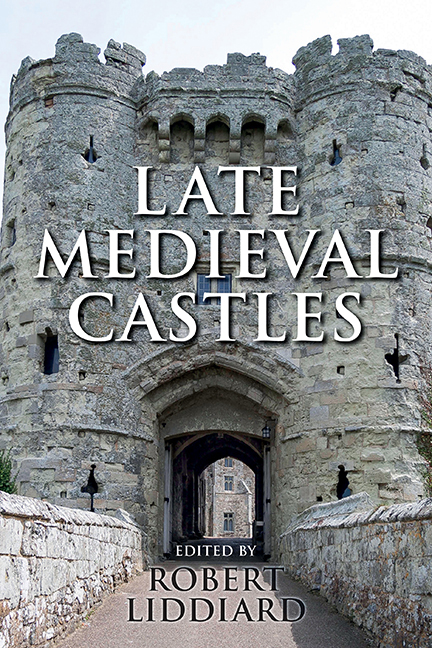Book contents
- Frontmatter
- Contents
- List of Illustrations
- Acknowledgements
- Editor's Preface
- List of Abbreviations
- A Note on the Text
- Introduction
- 1 Fourteenth-Century Castles in Context: Apotheosis or Decline?
- 2 Architects, Advisors and Design at Edward I's Castles in Wales
- 3 The Courtyard and the Tower: Contexts and Symbols in the Development of Late Medieval Great Houses
- 4 Castle Planning in the Fourteenth Century
- 5 Meaningful Constructions: Spatial and Functional Analysis of Medieval Buildings
- 6 Mota, Aula et Turris: The Manor-Houses of the Anglo-Scottish Border
- 7 Lulworth Castle, Dorset
- 8 A Scottish Problem with Castles
- 9 Structural Symbolism in Medieval Castle Architecture
- 10 Specimens of Freedom to Crenellate by Licence
- 11 Some Analysis of the Castle of Bodiam, East Sussex
- 12 English Castles in the Reign Of Edward II
- 13 Castles of Ward and the Changing Pattern of Border Conflict in Ireland
- 14 The Donjon Of Knaresborough: The Castle As Theatre
- 15 The Architecture of Arthurian Enthusiasm: Castle Symbolism in the Reigns of Edward I and his Successors
- 16 Medieval Ornamental Landscapes
- 17 Otherworld Castles in Middle English Arthurian Romance
- Guide to Further Reading
- Index
8 - A Scottish Problem with Castles
Published online by Cambridge University Press: 29 April 2017
- Frontmatter
- Contents
- List of Illustrations
- Acknowledgements
- Editor's Preface
- List of Abbreviations
- A Note on the Text
- Introduction
- 1 Fourteenth-Century Castles in Context: Apotheosis or Decline?
- 2 Architects, Advisors and Design at Edward I's Castles in Wales
- 3 The Courtyard and the Tower: Contexts and Symbols in the Development of Late Medieval Great Houses
- 4 Castle Planning in the Fourteenth Century
- 5 Meaningful Constructions: Spatial and Functional Analysis of Medieval Buildings
- 6 Mota, Aula et Turris: The Manor-Houses of the Anglo-Scottish Border
- 7 Lulworth Castle, Dorset
- 8 A Scottish Problem with Castles
- 9 Structural Symbolism in Medieval Castle Architecture
- 10 Specimens of Freedom to Crenellate by Licence
- 11 Some Analysis of the Castle of Bodiam, East Sussex
- 12 English Castles in the Reign Of Edward II
- 13 Castles of Ward and the Changing Pattern of Border Conflict in Ireland
- 14 The Donjon Of Knaresborough: The Castle As Theatre
- 15 The Architecture of Arthurian Enthusiasm: Castle Symbolism in the Reigns of Edward I and his Successors
- 16 Medieval Ornamental Landscapes
- 17 Otherworld Castles in Middle English Arthurian Romance
- Guide to Further Reading
- Index
Summary
This article examines the cultural misinterpretations that followed from the Scottish nobles’ fondness for adopting the title and martial appearance of castles for their Renaissance country seats. It examines the distortions and misunderstandings that led to the continuing presumption that Scotland did not participate in the European architectural Renaissance. Using contemporary sources, the buildings themselves and recent research, it offers a cultural explanation for the seemingly martial nature of Scottish architecture in terms of expressing rank and lineage, and proclaiming political allegiance. It suggests that a reinterpretation of such buildings as self-sustaining country seats can offer much to other social and cultural aspects of British history of that period. It concludes by suggesting that the architecture of the late seventeenth century, far from indicating a classicisation or assimilation with England, represented the apogee of a confident national architecture.
The architecture of the Scottish Renaissance is curiously absent from European historiography. It figures in English historiography only since the strangely picturesque qualities of the north-east country seats like Fyvie (1598) or Craigievar (1610–25), both in Aberdeenshire, permitted their entry as a minor aberration in the steadfast evolution of a British architecture (Figure 1). The reason for its absence is that no (or very little) Renaissance architecture appeared to be identifiable in Scotland according to the judgments of the time, and the Scottish nobility appeared to reside in medieval castles long after everybody else had ceased doing so. Since the architecture of such buildings followed neither contemporary trends in England, nor an identifiably classical approach, it was soon concluded that the Renaissance had largely passed Scotland by. Scots institutions shared that misconception even up to the late twentieth century. The Renaissance appeared to have fallen between the remit of the National Museum of Antiquities of Scotland and that of the Industrial Museum of Scotland (later the Royal Museum); and until the emergence of a brief for a new Museum of Scotland in 1986, the Scottish medieval period was assumed to extend to 1700, when its modern period began. The museums acknowledged little between.
The ubiquitous ‘heritage’ presentation of Scottish Renaissance country seats as military objects, supported by countless publications on ‘Scottish castles’ that mingle genuine fortresses promiscuously with sometimes very minor country seats, diminishes rather than enhances their interest.
- Type
- Chapter
- Information
- Late Medieval Castles , pp. 167 - 198Publisher: Boydell & BrewerPrint publication year: 2016



